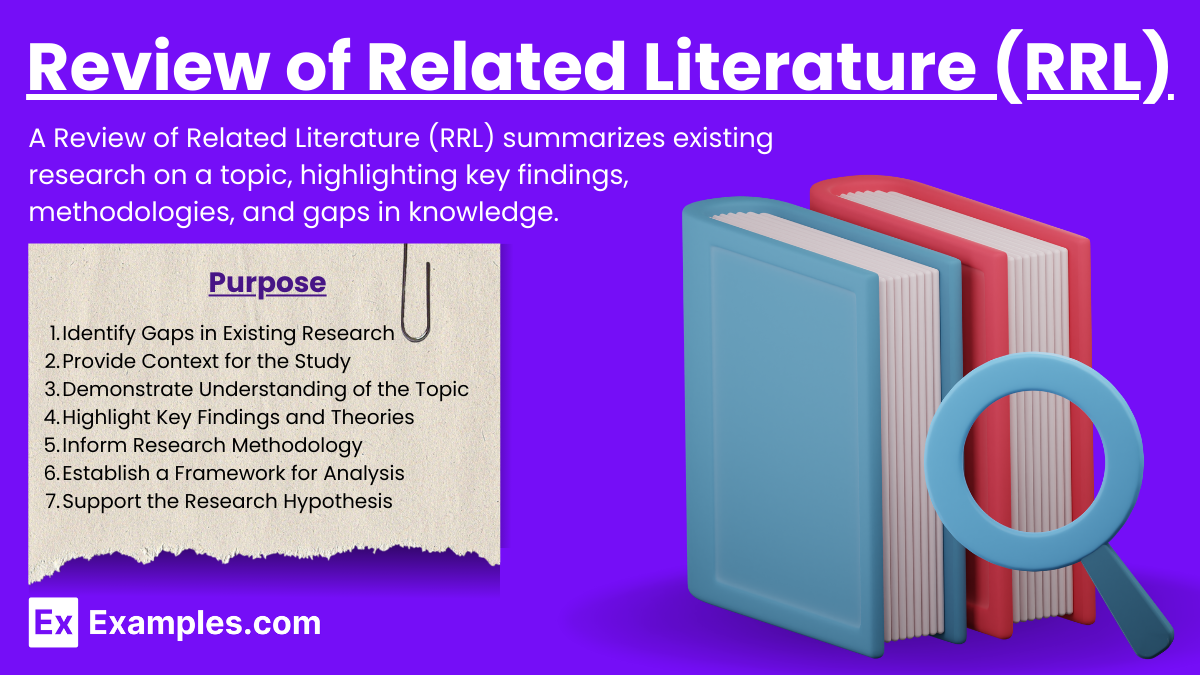10+ Review of Related Literature (RRL) Examples to Download
The Review of Related Literature (RRL) is a crucial section in research that examines existing studies and publications related to a specific topic. It summarizes and synthesizes previous findings, identifies gaps, and provides context for the current research. RRL ensures the research is grounded in established knowledge, guiding the direction and focus of new studies.
What Is Review of Related Literature (RRL)?
The Review of Related Literature (RRL) is a detailed analysis of existing research relevant to a specific topic. It evaluates, synthesizes, and summarizes previous studies to identify trends, gaps, and conflicts in the literature. RRL provides a foundation for new research, ensuring it builds on established knowledge and addresses existing gaps.
Format of Review of Related Literature (RRL)
The Review of Related Literature (RRL) is a critical part of any research paper or thesis. It provides an overview of existing research on your topic and helps to establish the context for your study. Here is a typical format for an RRL:
1. Introduction
- Purpose: Explain the purpose of the review and its importance to your research.
- Scope: Define the scope of the literature reviewed, including the time frame, types of sources, and key themes.
2. Theoretical Framework
- Concepts and Theories: Present the main theories and concepts that underpin your research.
- Relevance: Explain how these theories relate to your study.
3. Review of Empirical Studies
- Themes or Topics: Organize the literature by themes or topics relevant to your research.
- Sub-theme 1: Summarize key studies, including methodologies, findings, and conclusions.
- Sub-theme 2: Continue summarizing studies, focusing on different aspects or variables.
- Sub-theme 3: Include any additional relevant studies.
4. Methodological Review
- Approaches: Discuss the various methodologies used in the reviewed studies.
- Strengths and Weaknesses: Highlight the strengths and weaknesses of these methodologies.
- Gaps: Identify gaps in the existing research that your study aims to address.
5. Synthesis and Critique
- Integration: Integrate findings from the reviewed studies to show the current state of knowledge.
- Critique: Critically evaluate the literature, discussing inconsistencies, limitations, and areas for further research.
6. Conclusion
- Summary: Summarize the main findings from the literature review.
- Research Gap: Clearly state the research gap your study will address.
- Contribution: Explain how your study will contribute to the existing body of knowledge.
7. References
- Citation Style: List all the sources cited in your literature review in the appropriate citation style (e.g., APA, MLA, Chicago).
Sample:
Review of Related Literature (RRL)
1. Introduction
This review examines research on social media’s impact on mental health, focusing on anxiety and depression across various demographics over the past ten years.
2. Theoretical Framework
Anchored in Social Comparison Theory and Uses and Gratifications Theory, this review explores how individuals’ social media interactions affect their mental health.
3. Review of Empirical Studies
Adolescents’ Mental Health
- Instagram & Body Image: Smith & Johnson (2017) found Instagram use linked to body image issues and lower self-esteem among 500 high school students.
- Facebook & Anxiety: Brown & Green (2016) showed Facebook use correlated with higher anxiety and depressive symptoms in a longitudinal study of 300 students.
Young Adults’ Mental Health
- Twitter & Stress: Davis & Lee (2018) reported higher stress levels among heavy Twitter users in a survey of 400 university students.
- LinkedIn & Self-Esteem: Miller & White (2019) found LinkedIn use positively influenced professional self-esteem in 200 young professionals.
Adult Mental Health
- General Social Media Use: Thompson & Evans (2020) found moderate social media use associated with better mental health outcomes, while excessive use correlated with higher anxiety and depression in 1,000 adults.
4. Methodological Review
Studies used cross-sectional surveys, longitudinal designs, and mixed methods. Cross-sectional surveys provided large data sets but couldn’t infer causation. Longitudinal studies offered insights into long-term effects but were resource-intensive. Mixed methods enriched data through qualitative insights but required careful integration.
5. Synthesis and Critique
The literature shows a complex relationship between social media and mental health, with platform-specific and demographic-specific effects. However, reliance on self-reported data introduces bias, and many cross-sectional studies limit causal inference. More longitudinal and experimental research is needed.
6. Conclusion
Current research offers insights into social media’s mental health impact but leaves gaps, particularly regarding long-term effects and causation. This study aims to address these gaps through comprehensive longitudinal analysis.
7. References
- Brown, A., & Green, K. (2016). Facebook Use and Anxiety Among High School Students. Psychology in the Schools, 53(3), 257-264.
- Davis, R., & Lee, S. (2018). Twitter and Psychological Stress: A Study of University Students. Journal of College Student Development, 59(2), 120-135.
- Miller, P., & White, H. (2019). LinkedIn and Its Effect on Professional Self-Esteem. Journal of Applied Psychology, 104(1), 78-90.
- Smith, J., & Johnson, L. (2017). The Impact of Instagram on Teen Body Image. Journal of Adolescent Health, 60(5), 555-560.
- Thompson, M., & Evans, D. (2020). The Relationship Between Social Media Use and Mental Health in Adults. Cyberpsychology, Behavior, and Social Networking, 23(4), 201-208.
Review of Related Literature (RRL) Examples
- Review of Related Literature in Research
- Review of Related Literature in Research Paper
- Review of Related Literature Qualitative Research
- Review of Related Literature Qualitative Research
Review of Related Literature in Research
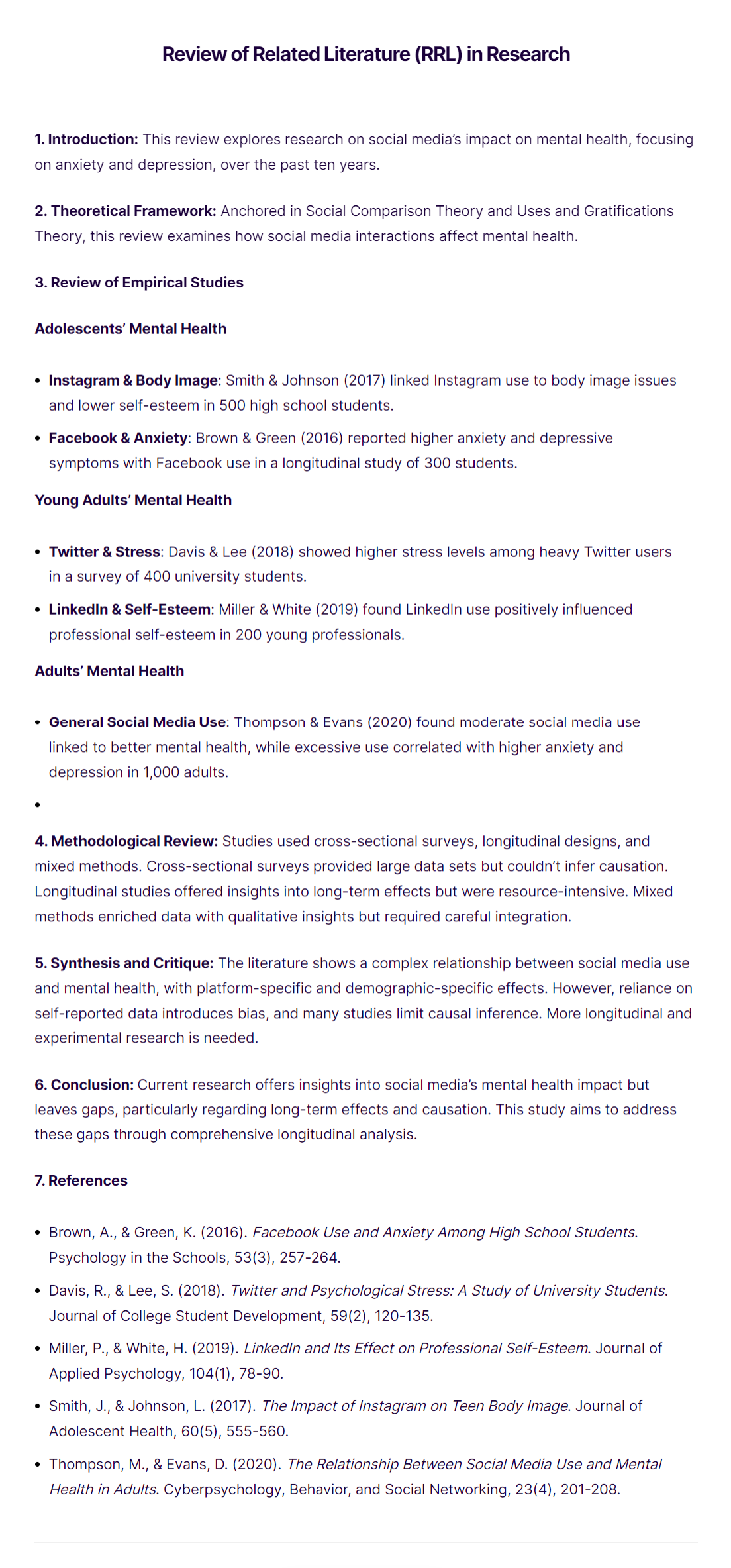
Review of Related Literature in Research Paper
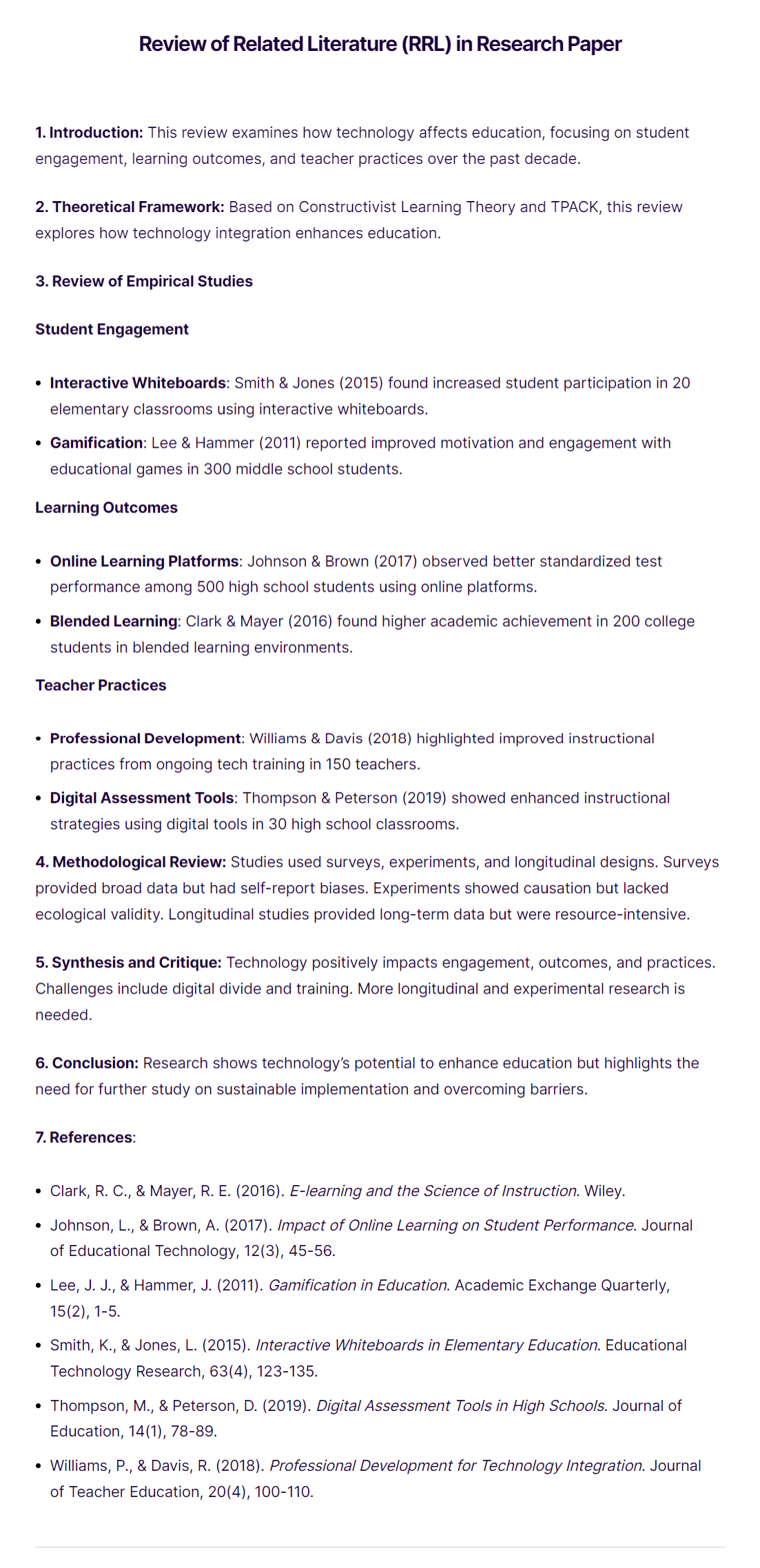
Review of Related Literature Qualitative Research
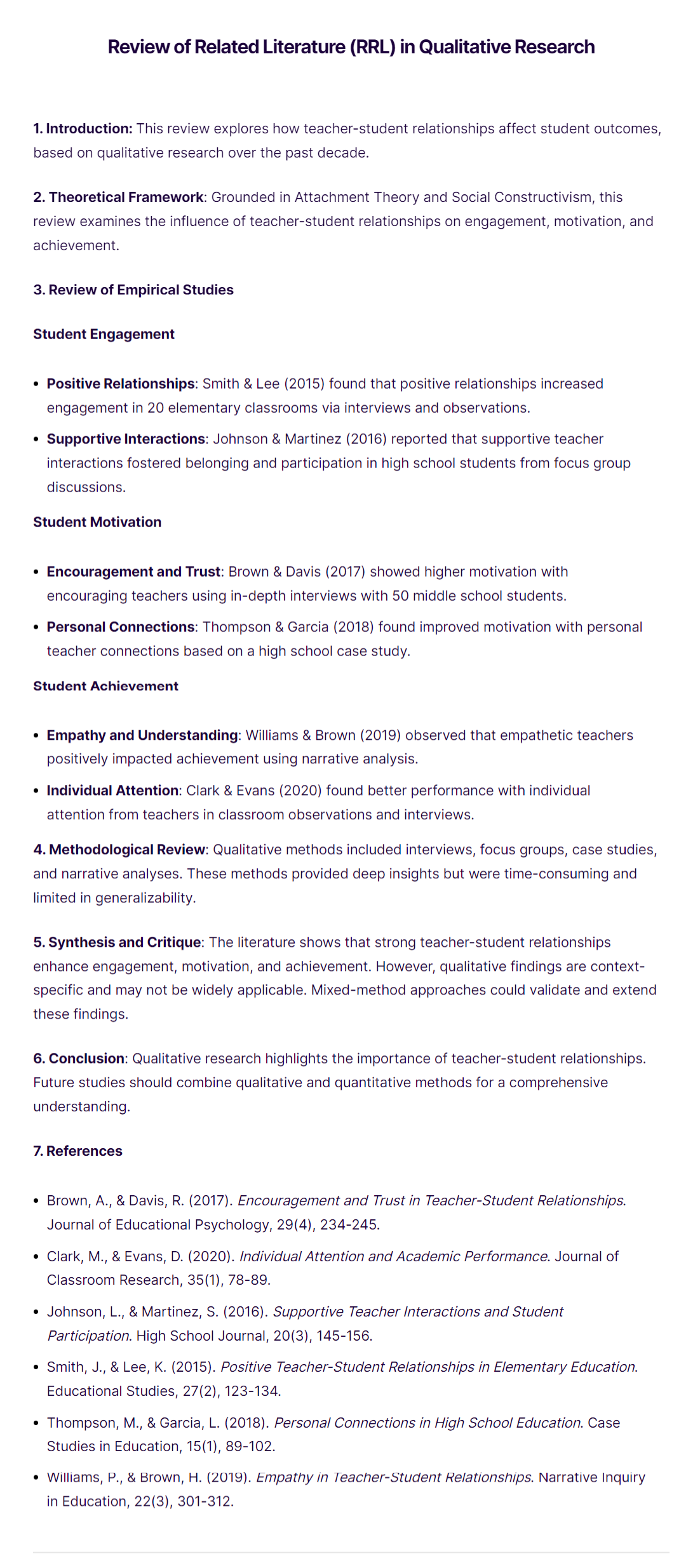
Review of Related Literature Quantitative Research
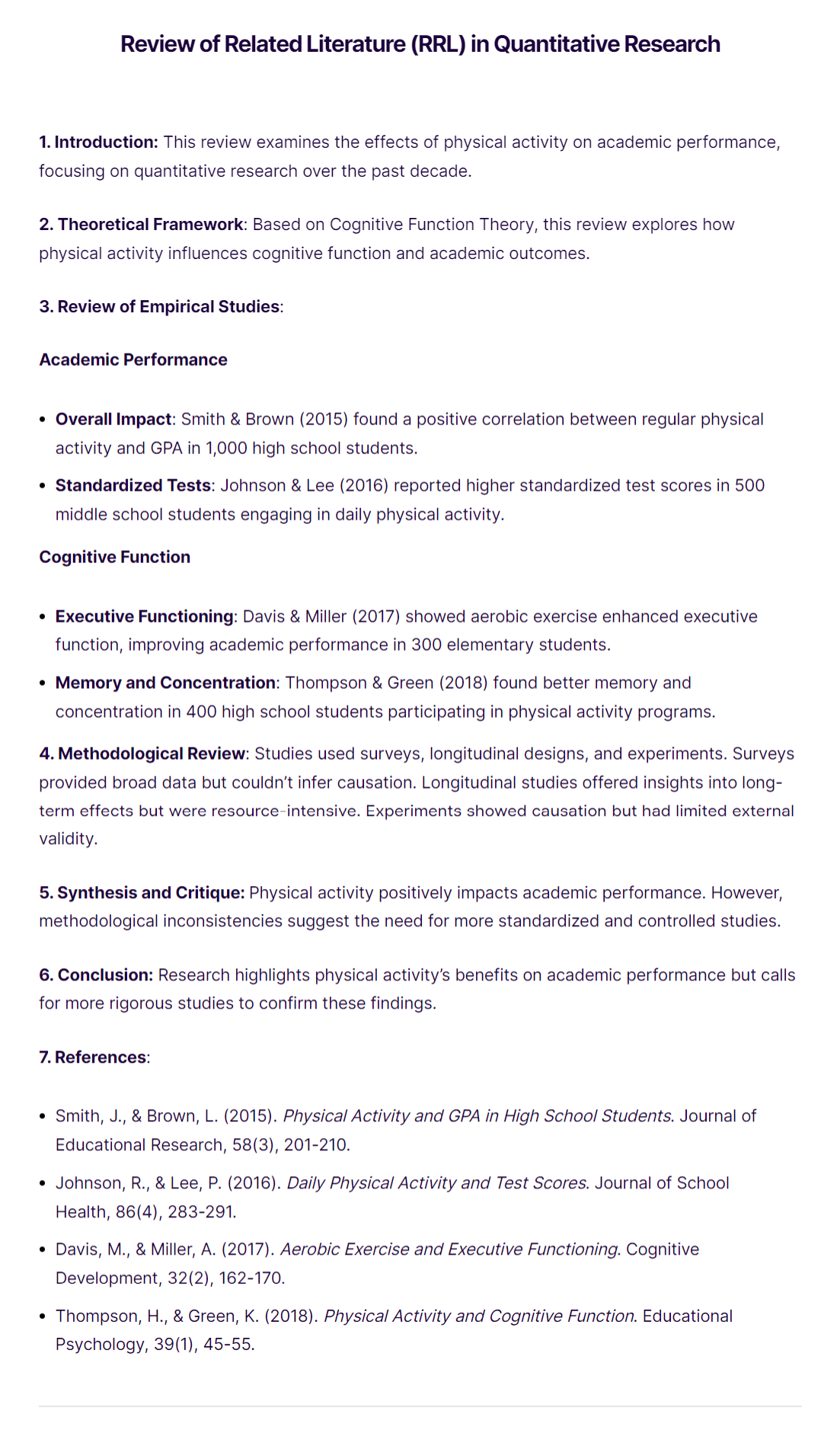
More Review of Related Literature (RRL) Examples
- Impact of E-learning on Student Performance
- Effectiveness of Mindfulness in Workplace
- Green Building and Energy Efficiency
- Impact of Technology on Healthcare Delivery
- Effects of Nutrition on Cognitive Development in Children
- Impact of Employee Training Programs on Productivity
- Effects of Climate Change on Biodiversity
- Impact of Parental Involvement on Student Achievement
- Effects of Mobile Learning on Student Engagement
- Effects of Urban Green Spaces on Mental Health
Purpose of the Review of Related Literature (RRL)
The Review of Related Literature (RRL) serves several critical purposes in research:
- Establishing Context: It situates your research within the broader field, showing how your study relates to existing work.
- Identifying Gaps: It highlights gaps, inconsistencies, and areas needing further exploration in current knowledge, providing a clear rationale for your study.
- Avoiding Duplication: By reviewing what has already been done, it helps ensure your research is original and not a repetition of existing studies.
- Building on Existing Knowledge: It allows you to build on the findings of previous research, using established theories and methodologies to inform your work.
- Theoretical Foundation: It provides a theoretical basis for your research, grounding it in existing concepts and theories.
- Methodological Insights: It offers insights into the methods and approaches used in similar studies, helping you choose the most appropriate methods for your research.
- Establishing Credibility: It demonstrates your familiarity with the field, showing that you are well-informed and have a solid foundation for your research.
- Supporting Arguments: It provides evidence and support for your research questions, hypotheses, and objectives, strengthening the overall argument of your study.
How to Write Review of Related Literature (RRL)
Writing a Review of Related Literature (RRL) involves several key steps. Here’s a step-by-step guide:
1. Define the Scope and Objectives
- Determine the Scope: Decide on the breadth of the literature you will review, including specific themes, time frame, and types of sources.
- Set Objectives: Clearly define the purpose of the review. What do you aim to achieve? Identify gaps, establish context, or build on existing knowledge.
2. Search for Relevant Literature
- Identify Keywords: Use keywords and phrases related to your research topic.
- Use Databases: Search academic databases like Google Scholar, PubMed, JSTOR, etc., for relevant articles, books, and papers.
- Select Sources: Choose sources that are credible, recent, and relevant to your research.
3. Evaluate and Select the Literature
- Read Abstracts and Summaries: Quickly determine the relevance of each source.
- Assess Quality: Consider the methodology, credibility of the authors, and publication source.
- Select Key Studies: Choose studies that are most relevant to your research questions and objectives.
4. Organize the Literature
- Thematic Organization: Group studies by themes or topics.
- Chronological Organization: Arrange studies in the order they were published to show the development of ideas over time.
- Methodological Organization: Categorize studies by the methods they used.
5. Write the Review
- Introduction:
- State the purpose and scope of the review.
- Explain the importance of the topic.
- Body:
- Theoretical Framework: Present and discuss the main theories and concepts.
- Review of Empirical Studies:
- Summarize key studies, including their methodologies, findings, and conclusions.
- Organize by themes or other chosen organizational methods.
- Methodological Review: Discuss the various methodologies used, highlighting their strengths and weaknesses.
- Synthesis and Critique: Integrate findings, critically evaluate the literature, and identify gaps or inconsistencies.
- Conclusion:
- Summarize the main findings from the literature review.
- Highlight the research gaps your study will address.
- State how your research will contribute to the existing knowledge.
6. Cite the Sources
- Use Appropriate Citation Style: Follow the required citation style (e.g., APA, MLA, Chicago).
- List References: Provide a complete list of all sources cited in your review.
What is an RRL?
An RRL summarizes and synthesizes existing research on a specific topic to identify gaps and guide future studies.
Why is RRL important?
It provides context, highlights gaps, and ensures new research builds on existing knowledge.
How do you write an RRL?
Organize by themes, summarize studies, evaluate methodologies, identify gaps, and conclude with relevance to current research.
What sources are used in RRL?
Peer-reviewed journals, books, conference papers, and credible online resources.
How long should an RRL be?
Length varies; typically 10-20% of the total research paper.
What are common RRL mistakes?
Lack of organization, insufficient synthesis, over-reliance on outdated sources, and failure to identify gaps.
Can an RRL include non-scholarly sources?
Primarily scholarly, but reputable non-scholarly sources can be included for context.
What is the difference between RRL and bibliography?
RRL synthesizes and analyzes the literature, while a bibliography lists sources.
How often should an RRL be updated?
Regularly, especially when new relevant research is published.
Can an RRL influence research direction?
Yes, it identifies gaps and trends that shape the focus and methodology of new research.



